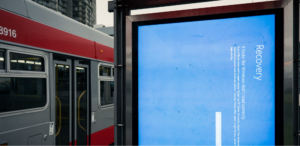Making several displays work cohesively inside a single room can be a challenge. If the displays are set in different sections of the location, or even across the country it gets even tougher. Without software in play to tie everything together, maintaining digital signage consistency across multiple locations would be very difficult. Your own creativity and standards are responsible for setting up brand style and tone. Meanwhile, the software is there to make everything consistent and neat. It may take some time to build everything up, but you have to begin somewhere and in the long run you will reap the benefits as it makes your life so much easier!
Outline branding standards and guidelines
If it’s any good, your content will change frequently. However, there are certain things which should never change. Use a consistent color palette with the colors of your corporate identity and matching colors for secondary accents. Wherever you add a frame outline, a subtle transitional glow, or a background to fill in the gaps, be consistent with the choice of color tied to your brand. The viewer will get used to the layout and recognize your style outdoors. Indoors, you’ll create a feeling of familiarity for returning customers. This consistency also translates to your branding on other channels.
Stick to one or two primary fonts which align with your branding, as well as font sizes for headlines, subheadings, and smaller bits of text. Of course, you’ll want to run some exciting video campaigns which are more unique and try out new things, but keep the majority of your content uniform. Set a consistent messaging tone, for example, formal, playful, or casual. Define which one suits the context best and stick to it. A bank might use a more matter-of-fact and formal approach, while a gym would be more motivational and high-energy.
Don’t be afraid to switch things up and tweak your color schemes, try new fonts, or writing styles. Yet, eventually it’s important to settle on standards which are maintained for a time and allow the viewer to get used to them. This way, the impression is consistent for your digital signage across multiple locations, not only one.
Centralized content management
For all content deployment and design to be uniform, it is imperative your displays are interconnected. Digital signage software acts as the central hub for everything, giving you a clear overview of all displays, content elements, and schedules. While some software providers are designed for smaller layouts, others are designed for franchise-sized businesses. There are also software providers like OnSign TV who scale with business size, allowing you as much complexity as you need.
With digital signage software, you can separate displays, content, and even staff members into different groups. If you are consistent with your filing structure and labeling, deployment of content across hundreds of displays can be done in one action. Similarly, well set up layouts will allow you to roll out updates of menu prices or color schemes in seconds. Another important part software plays is in notifying you when one of your many displays encounters an issue you’d otherwise miss. In essence, software is a must-have tool in today’s growing world of digital signage. Here are some tips on finding the ideal one for you.
Maintain hardware and resolution standards
This particular step is best employed at the very beginning of your digital journey. As you pick out hardware components or go through the upgrade process, it would be wise to stick to consistent display sizes and resolutions. This will ensure that your previews and testing on one display are accurately replicated to all others.
In case you already have various sizes and resolutions available, tagging them in your player profiles can help keep an eye on those particular devices. You may even create separate templates of your main content to deploy to those screens to ensure consistency.
Prepare for trouble!
In order to maintain digital signage consistency across multiple locations, it is imperative you have a way of checking on all of them. Most software providers these days offer some form of remote viewing and even control of your displays. Of course, you’ll only want to make use of that feature once the system notifies you there’s an issue of some sort. A failed playback caused by a hardware malfunction, for example, can alert you to an important issue.
On that note, use digital signage software to set up a Fallback Loop. These are useful if the main content runs into an issue. Someone may have accidentally deleted a file still in use on a few displays. Your software will quickly fill in the gap with backup content, then notify you of the fact. You’ll have plenty of time to fix it before the viewer notices anything!
Create location-specific customization
You may be tempted to create a system where you simply push one piece of content to every available display. In a sea of displays, it’s easy to forget the little tweaks you made along the way.
Tags, as we said, play a huge role in large-scale content management. Let’s say you want to push out a brand new product release to each available display. At the step of publishing, tags can allow you to run a last-moment check of everything and only include players which have specific labels, such as Promotions, Products, Sales, and Storefront. Meanwhile, you may want to ignore players such as Entertainment, Menu Board, or Internal.
Another important part of the digital signage toolset is scheduling. Different locations may benefit from different schedules based on audience behavior. If this is the case, you have the ability to schedule your content playlists for each location with care. Then simply update the content within the playlists, ensuring not only the correct content is displayed, but also at the best possible time. Start building your templates and schedules right away with OnSign TV!
Cover image by Maria Teneva.







